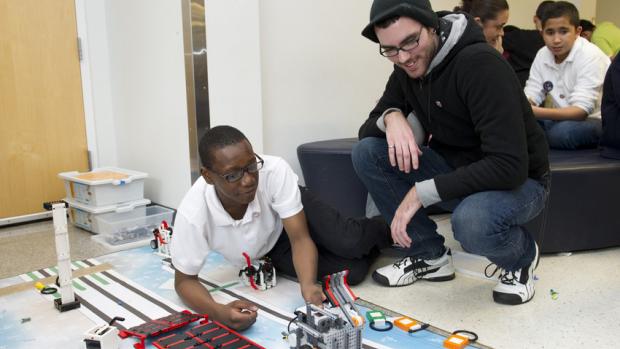Young Engineers Build a Robotic Bridge to Reach Seniors

Amid a sea of gray beards and walking canes, a small voice piped up, “Hey, who moved my NXT?” Adjusting his thick-rimmed faux reading glasses and taped-on Groucho moustache, the 5th grader took off in search of the missing robotics component, disappearing into the crowd of more than 400 elementary and middle school students gathered at the Polytechnic Institute of New York University for the qualifying round of the FIRST LEGO League (FLL) Robotics Championship this past weekend.
The competition, now in its 4th year at NYU-Poly, is a surefire way to get students as young as eight excited about engineering by letting them be engineers. Each year, FIRST issues a real-world problem that can be solved through robotics—LEGO robotics, to be specific. Thousands of students ages 9-14 take up the challenge, competing in local qualifying tournaments around the country with the hope of advancing to the final games this spring.
This year’s task, themed “Senior Solutions,” tested students’ abilities to improve quality of life for seniors. One glance around the gymnasium, where parents and siblings gather to cheer the competitors, reveals that the students took the challenge to heart—and to the funny bone—from the costume wigs and beards down to team t-shirts sporting phrases like “Get off My Lawn!”
Beneath the humor, the science speaks for itself. The students at Fort Greene Preparatory Academy show off their research project, a concept they deemed the “StopDrop.” Eighth grader David Rosa explains, “it’s a glove that prevents intention tremors in the hands, which are common among seniors. We designed it with nanobots in the fingertips, and it’s all programmed through a palm-sized motherboard.” Fatimah Alam, a 7th grader competing in FLL for the first time, chimed in “Our teacher’s dad has intention tremors, and we thought this idea could help him.”
The students turned to their grandparents and even interviewed local seniors in the community to devise their tech solutions, from “smart canes” equipped with terrain sensors and on-board lighting to a wireless glucose monitoring and insulin delivery system that uses microneedles to reduce discomfort.
More than half the teams hail from schools that participate in NYU-Poly’s Applying Mechatronics to Promote Science (AMPS) and Central Brooklyn STEM Initiative (CBSI), programs that pair NYU-Poly graduate students with elementary school teachers in disadvantaged schools. NYU-Poly fellows become a regular presence in the classroom, collaborating with teachers to design hands-on robotics lessons and instilling in students what they hope will be a lifelong interest in science and engineering.
“Everywhere you turn, you’re seeing kids who are ecstatic about robotics, and without this kind of attention in the classroom, you can be certain most of them would never have touched a circuit or learned how to program,” said Ben Esner, director of K-12 STEM Education, who has built NYU-Poly’s relationship with FLL over the past several years. “This is a model program for improving K-12 STEM education, and competitions like FLL are outstanding proving grounds to show the results.”
Vikram Kapila, professor of mechanical engineering at NYU-Poly and one of the founders of AMPS, adds, “the next generation of educational science standards are being reviewed right now, and for the first time, engineering will be incorporated. The STEM exposure these students are receiving—not just in the classroom but through competitions like FLL—links what they learn in school to real-life career prospects.”
For the fellows, the hard work they do with these young students and their teachers is one of the most rewarding parts of their year. Second-year fellows Jasmin Hume and Rezwana Uddin are barely a sentence into describing the work of their FLL teams—from the Community Partnership Charter School and P.S. 213, respectively—before they mention pride. “Students respond so well to this program, and they’re excited to do the research,” Uddin said. “They don’t realize they’re learning high-level concepts in mechanics engineering and design, and I’m so proud of their efforts.”
As the team from M.S. 442 marches past, chanting “LEGO Force!,” Esner says, “people often ask me what the kids win—a trophy, a medal, something they can show off. But I have one teacher here today—Saranii Muller from Fort Greene Preparatory Academy—who relentlessly called and emailed me for 10 weeks until we found a robotics fellow to mentor her class. It was that important to her, and the students take the competition very seriously. At the end of the day, sure, someone gets a trophy. But they all share the real prize—just being here means they’ve accomplished something difficult.”




